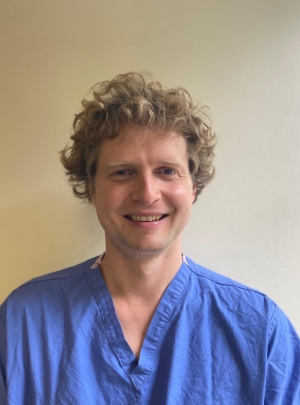9 October 2025

Congratulations to Timothy Jenkins, specialist physiotherapist at Royal Brompton and Harefield hospitals, who was recently awarded a Doctoral Clinical and Practitioner Academic Fellowship (DCAF) to develop a breathing exercise programme for patients in intensive care.
Funded by the National Institute for Health and Care Research (NIHR) the DCAF scheme funds registered health and care professionals to undertake a PhD. Timothy was part of the final cohort for this scheme which has now been rebranded to a Doctoral Award.
This comes after Timothy first completed a fellowship funded by Royal Brompton & Harefield Hospitals Charity followed by a Pre-doctoral Clinical Academic and Practitioner Fellowship (PCAF) from NIHR, which set him up to develop this doctoral fellowship application.
Ventilation, muscle weakness and breathing exercises
Over 200,000 adults are admitted to intensive care every year in the UK, and many of these individuals require support with their breathing using a ventilator machine.
Many patients on a ventilator machine quickly develop weakness in their diaphragm, the main breathing muscle. This muscle weakness can cause patients to remain on the ventilator for longer, which leads to a longer hospital stay and increases the risk of developing other health problems.
There is a particular type of breathing exercise called inspiratory muscle training where patients are encouraged to breathe against resistance through a small device, similar to breathing through a straw.
This type of muscle training aims to improve the strength of the diaphragm, thereby reducing the length of time a patient remains on a ventilator. However, research shows that current breathing exercise programmes do not help patients come off the ventilator or go home any sooner.
This may be due to current breathing exercises potentially strengthening the wrong muscles (i.e. chest and neck muscles).
Current breathing exercises can also be distressing for patients, which means many patients struggle to do the exercise.
Developing a new breathing exercise programme
Timothy’s project aims to develop a breathing exercise programme that focusses on strengthening the diaphragm and is not too distressing for patients.
The first part of the study will focus on patients who cannot breathe without a ventilator and will measure how the different breathing muscles respond to various levels of breathing exercise. The aim will be to determine which exercises make the diaphragm work the hardest and not in the other muscles (chest/neck).
Patients will also have the opportunity to feed back on their experience of each level of exercise.
The second part of the study will ascertain whether it is possible to conduct a large trial to determine if the breathing exercise programme developed in the first part of the study works (feasibility study).
This will involve patients randomly assigned to one of two groups with one group undergoing the study developed breathing exercise, and the second group receiving their usual care.
This will be followed by interviews with physiotherapists to determine how they felt undertaking these breathing exercises with patients.
On receiving the award, Timothy said:
“I am delighted to receive funding to conduct this important research which aims to identify a breathing exercise which is evidence based, and importantly, acceptable to patients. Although ventilation is a life saving intervention, patients frequently suffer from long-term health problems when they have been on a breathing machine for an extended time.
“This research aims to identify a breathing exercise which could help patients come off a ventilator sooner, potentially reducing the long-term health problems patients experience after intensive care.”
To find out more about our research, please contact us.
Read more research stories or sign up to the research newsletter.
